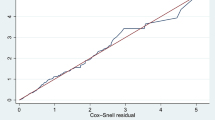Abstract
Objective: To determine the relationship between pacifier use and the duration of exclusive breast-feeding in the first six months of age, among poor children with unfavourable birth weight, from an underdeveloped region in Brazil.Method: Prospective cohort study with infants followed from birth to 6 months of age. Healthy children born with unfavourable birth weight (<3,000), being exclusively breastfed, were selected from 8 maternity hospitals in the city of Fortaleza (Brazil) between November 1996 and April 1997. Two main outcome measures were used: (i) time to stop exclusive breast-feeding at the 1st and (ii) at the 6th month of life. Main exposures were pacifier use at 1st and 6th month of age. Data were collected at maternity hospitals and during home interviews, using structured questionnaires, by trained data collectors unaware of the study aims, and analyzed using survival analysis and the Cox Proportional Hazard Model.Results: 500 children were enrolled and 13% were lost to follow up at the 1st month. Most of the families had a monthly income less than five times the minimum wage. One third of the mothers were adolescents, one fifth were working outside the home by the 6th month and most attended prenatal care visits. Approximately 60% of the children were using pacifiers by the 1st month. The average number of days for exclusive breast-feeding for pacifier use by the 6th month was 125.3 compared to 87.0 among non-users (p=0.0001). Children using pacifiers were 1,9 more likely to have stopped exclusive breastfeeding by the 6th month compared to non-users, even after controlling potential confounders.Conclusion: Pacifier use was associated with the early termination of breast-feeding in Brazil, among poor children with unfavourable birth weight, living in an underdeveloped area. As, a possible marker of early weaning, pacifier use can help health workers identify those mothers in need of extended counselling to reinforce breast-feeding practices.
Similar content being viewed by others
References
Black RE, Morris SS, Bryce J. Where and why are 10 million children dying every year?Lancet 2003; 361: 2226–2234
Puffer RR, Serrano CV.Carracteristicas del peso al nacer Washington, Organizacion Panamericana de la Salud, 1988; 112. (Scientific Publication 504).
Victora CG, Smith PG, Vaughan JP, Nobre LC, Lombardi C, Teixeira AMet al. Evidence for protection by breastfeeding against infant deaths from infections diseases in Brazil.Lancet 1987; 2: 319–321
Howard CR, Howard FM, Lanphear B, deBlieck EA, Eberly S, Lawrence RA. The effects of early pacifier use on breastfeeding duration.Pediatrics 1999; 103(3): E33
Aarts C, Hornell A, Kylberg E, Hofvander Y, Gebre-Medhin M. Breastfeeding patterns in relation to thumb sucking and pacifier use.Pediatrics 1999; 104(4):E50.
Vogel AM, Hutchison BL, Mitchell EA. Factors associated with the duration, of breastfeeding.Acta Pediatr 1999; 88(12): 1320–1326.
Organización Mundial De La Salud.Evidence for the Ten Steps to Successful Breastfeeding. Geneva: Division of Child Health and Development; 1998; 111. (WHO/CHD/98.9)
Soares, ME, Giugliani ER, Braun ML, Salgado AC, de Oliveira, AP, de Aguiar, PR. Pacifier use and its relationship with early wearning in infants born at a Child-Friendly Hospital.J Pediatr (Rio J) 2003; 79 (4): 309–316.
Vogel AM, Hutchison BL, Mitchell EA. The impact of pacifier use on breastfeeding: a prospective cohort study.J. Paediatr Child Health 2001;37(1):58–63
Dewey KG, Nommsen-Rivers LA, Heinig MJ, Cohen RJ. Risk factors for suboptimal infant breastfeeding behaviour, delayed onset of lactation, and excess neonatal weight loss.Pediatrics 2003; 112: 607–619.
Leite AM, Tavares M, Cunha AJLA. Effectiveness of Home-Based Peer Counselling to Promote Breastfeeding in the Northeast of Brazil: a Randomized Clinical Trial.J Pediatr (Rio J) 2000; 76 (suppl 1): S 63
Leite AJM, Marcopito LF, Diniz RLP, Silva AVS, Souza LCB, Borges JCet al. Perinatal deaths in the mmunicipality of Fortaleza: how many is it possible to avoid?J Pediatr (Rio J) 1997; 73(6): 388–394.
Silva ACet al.Vivo Criança: Os caminhos da sobrevivência infantil no ceara. 1st edn. Fortaleza: Demócrito Rocha; 1999.
McAuliffe J, Correia L, Victora CG. Segunda Pesquisa de Saúde Materno-Infantil do Ceará-PESMIC 3, 1990. Fortaleza: Project HOPE, 1994.
Organizacion Panamericana de la Salud. Organizacion Mundial de la Salud. Indicadores para Evaluar las Practicas de Lactancia Materna. Ginebra, Jun 1991
Benis MM. Are pacifiers associated with early weanning form breastfeeding?Adv Neonatal Care 2002; 2(5): 259–266.
Ullah S, Griffiths P. Does the use of pacifiers shorten breastfeeding duration in infants?Br J Community Nurs 2003; 8(10): 458–463.
Kramer MS, Barr RG, Dagenais S, Yang H, Jones P, Ciofani L et al. Pacifier use, early weaning, and cry/fuss behaviour: a randomized controlled trial.JAMA 2001; 286(3): 322–326.
Santiago LB, Bettiol H, Barbieri MA, Guttierrez MR, Del Campo LA. Promotion of breastfeeding: the importance of paediatricians with training.J Pediatr (Rio J) 2003; 79(8): 504–512.
Gove S. WHO Working Group on guidelines for IMCI. Integrated Management of Childhood Illness by outpatient health workers: technical basis and overview.Bull WHO 1997; 75 (Suppl 1): 7–24.
Author information
Authors and Affiliations
Corresponding author
Additional information
Project financed by the National Institute of Food and Nutrition (INAM—Ministry of Health), Ceará Public Health School and by the Child Health Division and Development of the World Health Organization (WHO).
Rights and permissions
About this article
Cite this article
da Cunha, A.J.L.A., Leite, A.M. & Machado, M.M.T. Breastfeeding and pacifier use in Brazil. Indian J Pediatr 72, 209–212 (2005). https://doi.org/10.1007/BF02859257
Published:
Issue Date:
DOI: https://doi.org/10.1007/BF02859257




